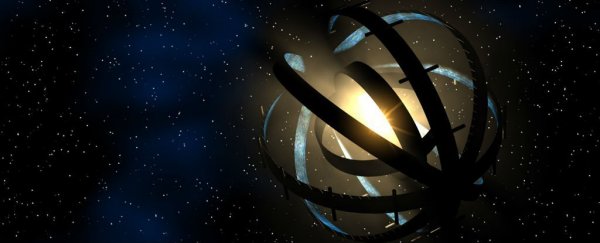Well, it had to come to an end some time. There's been a whole lot of buzz over KIC 8462852 - a star located about 1,500 light-years away between the Cygnus and Lyre constellations of our Milky Way galaxy. It's displaying such weird behaviour, one scientist even threw the possibility of an advanced alien civilisation building a giant Dyson sphere nearby.
But new research has come up with the most plausible explanation yet for KIC 8462852's weirdness - a barrage of comet fragments are spinning in a tight orbit around the star.
A bunch of citizen scientists were looking at measurements of KIC 8462852's brightness recorded by NASA's Kepler spacecraft, and while usual dips in brightness are about 1 percent - an indication that a planet is moving in front of the star - they found that KIC 8462852 is dipping in brightness by up to 22 percent, and in a way that scientists hadn't seen before.
Usually, the brightness dip would only be for a short time, but KIC 8462852's dips appear to be lasting for days and even months at a time and happening in a irregular pattern, different to that of a steadily orbiting planet.
So what is causing these dips? Scientists have speculated over a number of potential candidates. One was the hypothesis of a hording problem - KIC 8462852 having an orbit of space junk in tight formation around it. But this was ruled out as KIC 8462852 is a mature planet, and space junk generally only gets stuck in orbit when the star is young.
Another explanation was aliens, and it seemed like scientists were not ready to rule it out. The suggestion was that a giant alien megastructure was blocking the light as it attempted to harvest the sun's energy.
But alas, a new study has come up with another solution to the brightness dip problem, and it makes a whole lot more sense than aliens.
Writing in Astrophysical Journal Letters, a team of astronomers from Iowa State University conclude: "The scenario in which the dimming in the KIC 8462852 light curve were caused by the destruction of a family of comets remains the preferred explanation."
Massimo Marengo and his colleagues suggest that the destruction of a family of comets near the star is the most likely explanation for the irregular dimming. The comet fragments would likely create a steep, elliptical orbit, which could create the large debris needed to dim the star up to 22 percent.
The researchers used Spitzer infrared data from January 2015 - two years after the Kepler measurements - and discovered that no debris around the star is giving off infrared emissions. Using this information, they were able to determine that because there were no excess infrared emissions, explanations such as an asteroid belt collision; something having a large impact on a planet; or a cloud of rocks and debris can be rejected.
"The lack of strong infrared excess two years after the events responsible for the unusual light curve observed by Kepler further disfavours the scenarios involving a catastrophic collision in a KIC 8462852 asteroid belt, a giant impact disrupting a planet in the system or a population of dust-enshrouded planetesimals," they wrote in the paper. "The scenario invoking the fragmentation of a family of comets on a highly elliptical orbit is instead consistent with the lack of strong infrared excess found by our analysis."
But despite the evidence, they're still not ready to discount the alien megastructure idea entirely. "We can't really say it is, or is not," said Marengo. "But what the star is doing is very strange. It's interesting when you have phenomena like that - typically it means there's some new physical explanation or a new concept to be discovered."
